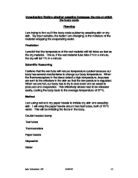As the solid candle wax is melted and drawn up into the wick, the wick embedded in the candle is progressively exposed. But the distance the liquid wax travels up the wick before becoming hot enough to vaporise does not change and so the top of the wick loses its cushion of insulating vapour, causing it to char and burn.
Sitting in my garden last night with just candles for light, I noticed that each one began to flicker and make a popping sound just before it finally fizzled out. Why does a candle do this, and what factors control the frequency of its dying flickers?
Candles are made out of paraffin wax, which is a mixture of hydrocarbons and is solid at room temperature. For a flame to form you need three things: fuel, oxygen and an ignition source. You also require the ratio of fuel to air to be within the flammable range.
For example, fire will not occur in an environment of 100 per cent methane, but a mixture of one part methane to one part oxygen will burn quite readily. When a candle is burning, it is not the solid wax that is burning, but the wax that is vaporising from the heat of the flame. These vapours are burnt off in the flame, so more heat is generated and more wax is vaporised.
To answer the question, when there is too much wind the flame may be extinguished, but it may reignite itself depending on a couple of factors.
The first is how hot the wick of the candle is, because this provides the ignition source. The second is how much vapour is present around the ignition source the fuel-to-oxygen ratio because when the flame goes out, parts of the candle are still vaporising.
If the oxygen and the temperature of the ignition source are at the required levels, the candle will reignite, and because there is a higher concentration of wax vapour than in a normal burning candle, it will cause the "pop" you hear. Even though the candle's flame is out for less than a second, this is long enough for the wax vapour to increase in concentration.
Incidentally, this sound can be used to detect the presence of hydrogen, and is called, not surprisingly, the "pop test".
We have tried the experiment taught by science teachers, in which a candle standing in water is covered by an upturned glass. The candle goes out and the water level rises in the glass. We are taught that the rising water level is caused by oxygen being consumed by the burning candle. However, if we have four candles burning under the glass instead of one, the water level rises much more. Why?
Emma's, Rebecca's and Andrew's questioning of the seemingly well understood candle experiment demonstrates how young and inquisitive minds are able to demolish false explanations propagated through school physics over the decades.
The consumption of oxygen may well contribute to the rising water level to a certain extent because a given mole volume of oxygen will burn the wax's carbon into roughly the same mole volume of carbon dioxide and the hydrogen into two mole volumes of water vapour respectively.
The former will partly dissolve into water, the latter will almost completely condense into liquid water. This will certainly lead to a net decrease in gaseous volume.
However, this is a minor consideration: the important influence is the heat created by the burning candle(s). By the time you cover the candle(s) with an upturned glass, an increased number of candles will have increased the air temperature around themselves more than a single candle would.
As soon as the candle(s) go(es) out, the surrounding air contracts as it cools and the ratio of contraction is directly proportional to the initial average temperature of the air volume under the glass. So more candles lead to more heat, a higher temperature and a higher water level upon cooling down.
All this tells us that we should never believe science teachers without asking a few pertinent questions first.







